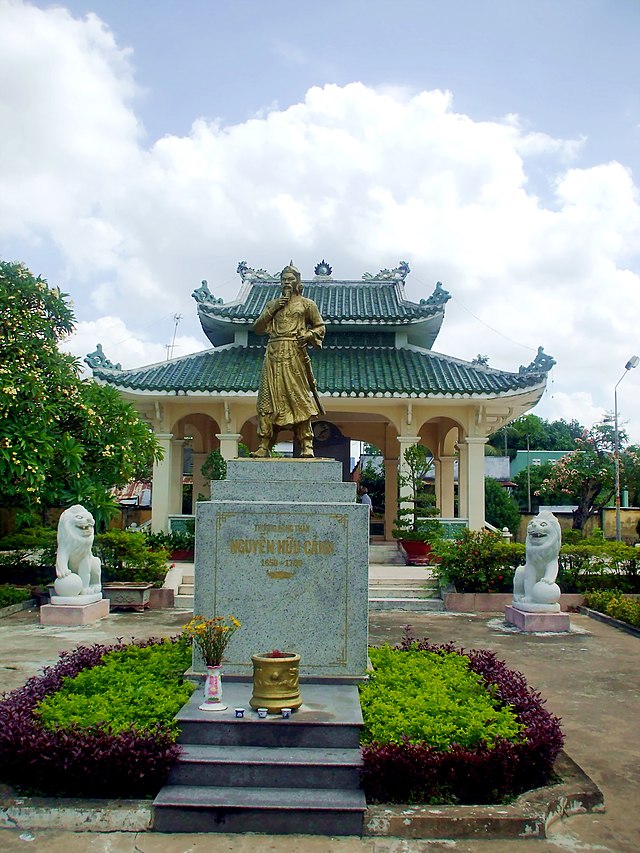Biên Hòa
City in Đồng Nai, Vietnam From Wikipedia, the free encyclopedia
City in Đồng Nai, Vietnam From Wikipedia, the free encyclopedia
Biên Hòa (Northern accent: , Southern accent: ) is the capital city of Đồng Nai Province, Vietnam, and is part of the Ho Chi Minh City metropolitan area. Situated northeast of Ho Chi Minh City (also known as Saigon), Biên Hòa is connected to it via National Route 1. As a class-1 provincial city, it is the sixth largest city in Vietnam by population.[2]
You can help expand this article with text translated from the corresponding article in Vietnamese. (March 2024) Click [show] for important translation instructions.
|
Biên Hòa
Thành phố Biên Hòa | |
|---|---|
| Biên Hòa City | |
From left to right, from top to bottom: Trấn Biên Temple of Literature, Buddha Mau Buu Hoa shrine, Ghềnh bridge | |
 | |
| Coordinates: 10°57′N 106°49′E | |
| Country | |
| Province | Đồng Nai |
| Region | Southeast |
| Area | |
| • Total | 263.62 km2 (101.78 sq mi) |
| Population (2024) | |
| • Total | 1,143,000 |
| • Density | 4,826/km2 (12,500/sq mi) |
| Metro GDP (PPP, constant 2015 values) | |
| • Year | 2023 |
| • Total | $19.8 billion[1] |
| • Per capita | $17,800 |
| Climate | Aw |
Biên Hòa spans 264 square kilometers of midland terrain in western Đồng Nai Province. The majority of the city is situated to the east of the Đồng Nai River.
Biên Hòa shares its borders with:[3]
Biên Hòa has 30 divisions (29 wards and 1 commune), including:[4]
In 1989, Biên Hòa's population was estimated at 273,879. By 1999, it had grown to 435,400 and reached 701,194 in 2009.[5] In December 2012, the city's population surpassed one million.[6] By 2019, it had increased to 1,055,414.[7]
As of 2021, the city's population was 1,119,190.[8]



The capture of Biên Hòa on 16 December 1861, was an important allied victory in the Cochinchina Campaign (1858–62). This campaign, fought between the French and the Spanish on the one side and the Vietnamese (under the Nguyễn dynasty) on the other, began as a limited punitive expedition and ended as a French war of conquest. The war concluded with the establishment of the French colony of Cochinchina, a development that inaugurated nearly a century of French colonial dominance in Vietnam.[citation needed]
Biên Hòa grew into a major suburb of Saigon as the capital city of the Republic of (South) Vietnam grew. Following the First Indochina War, tens of thousands of refugees from the northern and central regions of Vietnam—a large portion of whom were Roman Catholics—resettled in Biên Hòa as part of Operation Passage to Freedom. During the Vietnam War, the United States Air Force operated Biên Hòa Air Base near the city. Mortar attacks on U.S. and ARVN targets were frequently staged from residential districts in Biên Hòa. Two of the better-known attacks took place during Tết of 1968 as well as 1969.[9]
Because of its large population of former refugees and their descendants who fled North Vietnam's communist government in the mid-1950s, Biên Hòa was a center of resistance against the communist government in the months immediately following the fall of the Republic of Vietnam.[citation needed]
Like much of Vietnam, post-war Biên Hòa suffered a period of severe economic decline between 1975 and the second half of the 1980s. However, after the government of the Socialist Republic of Vietnam introduced Đổi Mới, a series of economic and political reforms in 1986, Biên Hòa experienced significant economic growth. The city and its surrounding areas attracted substantial foreign investment, leading to industrialization and development.[10]
By 2005, Biên Hòa had become an industrial hub of southern Vietnam. Many factories and warehouses (often funded in collaboration with Japanese, Singaporean, American, Swiss and other foreign investors) operate in the areas surrounding the city.
With regard to entertainment, the city includes several amusement parks, nightclubs and restaurants lining the Đồng Nai River. Construction has increased rapidly, with many Western-style houses and villas under development. The real estate market has experienced a series of boom cycles since the mid-1990s.[11]
Biên Hòa is home to Bình An Cemetery (also known as Biên Hòa Military Cemetery), a large national cemetery for fallen soldiers and military officials of the former Republic of Vietnam (ARVN). After the fall of Saigon, the cemetery was ransacked and subsequently abandoned.[12] The Vietnamese American Foundation, also known as The Returning Casualty, is working to restore the cemetery and excavate a nearby mass grave of approximately 200 ARVN soldiers.[13]
At the end of 2015, the Prime Minister of Vietnam issued Decision No.2488/QD-TTg recognizing Biên Hòa as a class-1 provincial city.[14]
Biên Hòa is a key industrial hub in southern Vietnam. There are six industrial zones:
Sanyang Motor's Vietnam Manufacturing & Export Processing Co., Ltd. (VMEP) is located in Biên Hòa.
Biên Hòa Air Base served as the main storage and handling site for Agent Orange during the Vietnam War and remains the largest dioxin hotspot in Vietnam.[18] U.S. and Vietnamese authorities are working to clean up the affected areas.[18][19]
Seamless Wikipedia browsing. On steroids.
Every time you click a link to Wikipedia, Wiktionary or Wikiquote in your browser's search results, it will show the modern Wikiwand interface.
Wikiwand extension is a five stars, simple, with minimum permission required to keep your browsing private, safe and transparent.